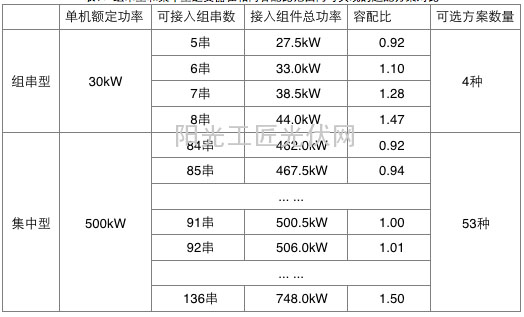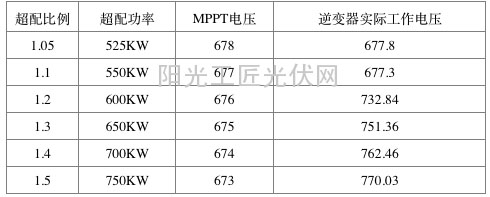Inverter Selection and Impact in Over-provisioning: Components in PV System Design
Through a reasonable over-provisioning design, the photovoltaic system can be optimized, the power generation capacity can be further increased, the systemized average cost of electricity (LCOE) can be further reduced, and the overall income of the investor can be further improved.
In the design of over-provisioning of components, it is necessary to consider the influence of local lighting conditions, system losses, laying inclination angles, etc. At the same time, the performance and selection of inverters are also very important. The centralized inverter is more suitable for over-provision than the string inverter due to its large capacity and strong overload capacity. In addition, since the capacity of the components that access the inverter is increased after over-provisioning, the operating range of the inverter will not be exceeded, resulting in long-term overload operation of the inverter and affecting the safety of the inverter. When the power is limited, the DC voltage will not exceed the allowable range of the inverter? With these questions, we did a detailed analysis.
I. Centralized inverter design is more flexible
In photovoltaic system design, photovoltaic modules are connected to the inverter in units of strings. Taking the common ground power plant as an example, generally each string of 22 components is calculated at 250 Wp per block, that is, the power of each string is 5500 W. In the system design, no matter whether the over-distribution is performed or not, whether it is the centralized type or the string type, the solution must meet the basic requirement that the capacity of the components connected to each inverter is an integral multiple of 5500 W.
The string ratio inverter with a rated power of 30 kW and the centralized inverter with a rated power of 500 KW in the domestic market can be used to compare the over-provisioned capacity ratio schemes, as shown in the following table:
Table 1: Comparison of over-provisioning schemes that can be realized in the same range of capacity ratios for string and centralized inverters

As shown in Table 1, between the volume ratio (capacity ratio = component power/inverter rated power) 0.92 to 1.50, 30KW string inverters can be realistic 4 options, 500KW centralized inverter can be 53 kinds of solutions are realized; that is to say, in the case of a ratio of 1.5 or less, only 3 types of over-provisioning designs are used for a string-type inverter of 30 KW, and a centralized type inverter of 500 KW can have 46 over-type solutions. Designed to meet the needs of different project configurations.
In addition, the string inverters of department manufacturers, the number of DC input terminals are configured in accordance with the standard rated capacity, can not access more string number, especially for poor lighting resources in the second and third areas, including When the ratio can be relatively large, due to the limitation of the number of input terminals, it is impossible to achieve the optimal ratio of capacitance. However, in the centralized inverter solution, because there is a convergence link of the DC convergence box to the string, it can be connected. The number of incoming strings is basically unlimited, and it is very flexible when performing over-provisioning.
Second, the impact of super-pairing inverter
When over-provisioning, because the component capacity exceeds the capacity of the inverter, what impact on the safe operation of the inverter?
1. Does the inverter overload
When compensating the over-distribution, the maximum power actually output by the inverter after the system loss is removed is equal to the power of the inverter. It is easy to understand within the normal operating range of the inverter. In active over-distribution, after removing system losses, if the components are all operating at the maximum power point, the inverter power will be exceeded, which will cause the inverter to run overloaded and even exceed the operating range of the inverter to reach the inverter. Overload protection point, this is not allowed. How to solve this problem? The only solution is to limit the output of the component, that is, through inverter control, so that the component output deviates from the maximum operating point to ensure that the inverter output does not exceed its rated power. It can be seen that over-provisioning only increases the time for full-load operation of the inverter and improves the utilization of the inverter. The inverter will not be overloaded and will not exceed the operating range of the inverter.
2. What impact will there be on limited power operation?
From the output characteristics of the module, it can be seen that during the active over-distribution, the output of the inverter control component deviates from the maximum power point due to limited power operation during part of the system time period, as shown in the figure below, when the working point deviates to the right from point A to At point C, the component output current decreases and the output voltage rises.

Deviation of component work points during active over-provisioning with limited power operation
As can be seen from the graph in Figure 1, when the power of the over-provisioning is larger, the limited power is also greater, the smaller the output current of each module is, the more the work point of the module shifts to the right, and the voltage is higher, that is to say, super. The greater the power distribution, the higher the output voltage. Through analysis and calculation, the actual working voltage of the inverter at different ratios can be obtained as shown in Table 2. It can be seen that when the volume ratio is 1.5 times, the actual operating voltage of the inverter is raised from the MPPT voltage of 673V to 770V, which is within the allowable operating range of the inverter. In other words, the system's DC voltage will not affect the safe operation of the inverter even when it is over 1.5 times.

Table 2 The actual over-voltage of the inverter in different over-proportioning ratios
Third, summary
Through analysis, in the process of system over-provisioning design, the selection of inverter is very critical. Since the ratio of stand-alone capacity and single string capacity is large, and the overload capacity is strong, the centralized inverter can be easily configured in different proportions. The design is flexible and meets the requirements of different regional capacities. At the same time, reasonable super-pairing inverters and systems do not have any influence on the normal operation and will not exceed the safe operating range of the inverter.
Cast Blockers,Mould Inoculants,Calcium Silicon Barium Lumps,Calcium Silicon Inoculants Lumps
Anyang Xinyi Alloy Co.,Ltd. , https://www.xyferroalloy.com